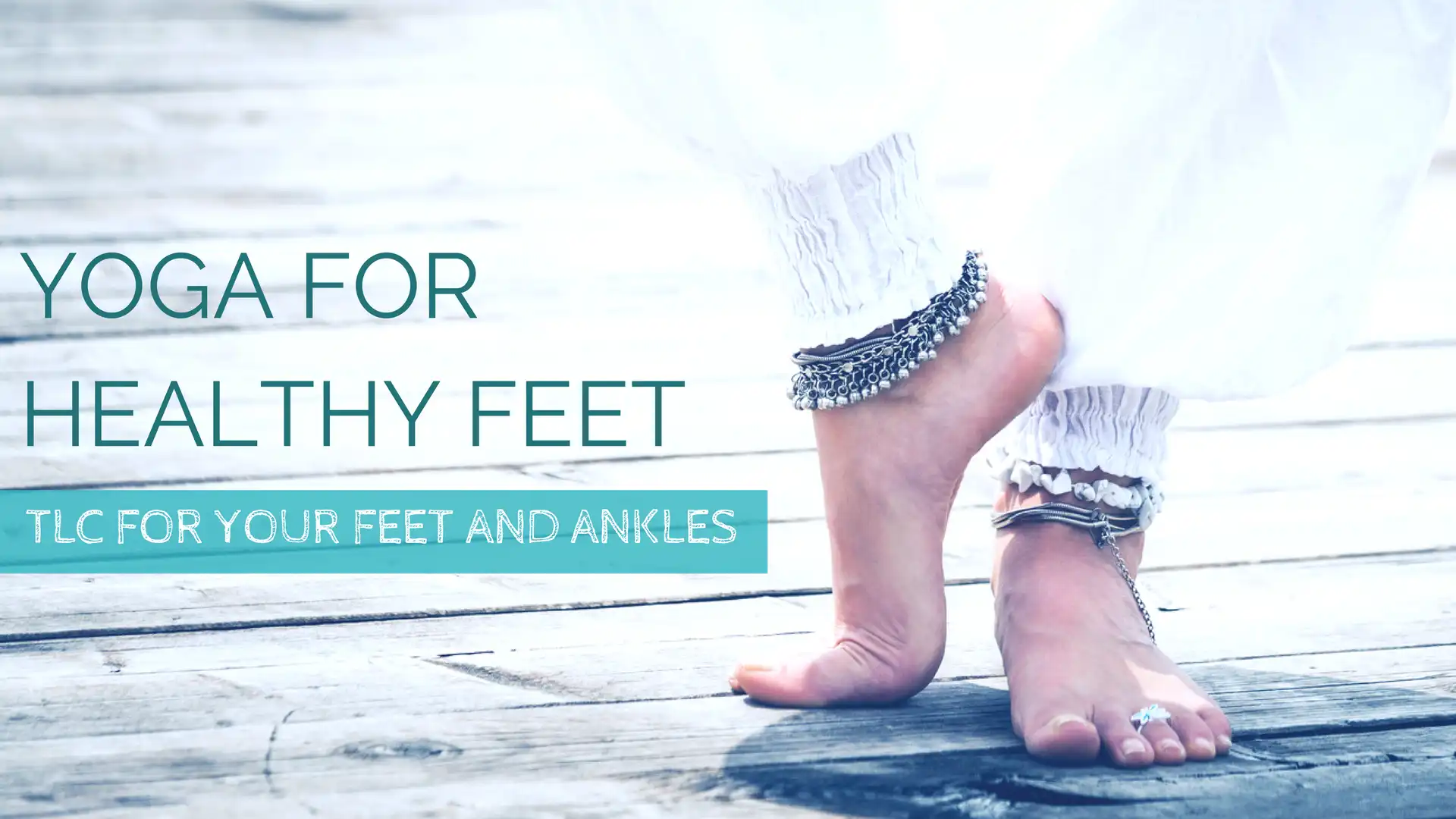Yoga for Healthy Feet: TLC for Your Feet and Ankles

On the list of reasons people practice yoga, maintaining the health of their feet and ankles is rarely in the top five. And yet, these parts of the body are so vital for wellbeing.
Your feet form your foundation and your connection to the earth anytime you walk, run, dance, or simply stand on your legs. How they connect with the earth impacts the alignment of your entire body, like a chain reaction that runs from your feet through your ankles, legs, pelvis, spine, all the way up to the crown of your head.
Over time, neglecting your feet and ankles could have serious consequences. There are a number of painful conditions that could arise if you forget to take care of them, such as plantar fasciitis, heel spurs, tendinitis, shin splints, bunions, and osteoarthritis.
How Yoga Benefits Your Feet
Although it may not have been your number one reason for taking up yoga, your asana practice offers many opportunities to develop both strength and flexibility in your feet and ankles—as long as you pay attention to a few key factors:
• Alignment
• Stretching and strengthening
• Modifying
For healthy and pain-free feet and ankles, it’s important to practice proper alignment principles; stretch and strengthen your feet, ankles, and lower legs; and use intelligent modifications when necessary.
Alignment of the Feet in Yoga
-
To find the proper alignment of you feet in yoga, start by identifying the four corners of your feet:
A. Inner heel
B. Pinky toe mound
C. Big toe mound
D. Outer heel
Press your inner heel into the floor, then your pinky toe mound. Creating this diagonal line across your foot engages muscles deep within it. Next, press down into your big toe mound, then your outer heel.
When you root equally through all four corners, the muscles of the feet strengthen and engage. This, in turn, affects the muscles of the ankle, lower leg, knee, and thigh, helping them to engage evenly and create a firm, steady, and balanced foundation for standing poses.
-
Whenever your feet are planted on the floor, notice if any of the four corners bears more weight than the others. As much as possible, spread your weight evenly among the four corners.
-
At the same time that the four corners of your feet are rooting down, lift your arches. Feel that lift travel like a current of energy all the way up the muscles of your ankles and legs.
-
Spread your toes and lengthen them forward, away from the heels.
A Simple 5-minute Yoga Routine for Healthy Feet
-
Lie on your back with your knees bent and the soles of your feet on the floor. Hug your right knee towards your chest and interlace your fingers behind the knee. Keeping the right knee bent, flex your right foot by pulling the toes back towards your shin. This movement is called dorsiflexion. Next, point your foot by moving the toes forward, away from the shin—a movement called plantar flexion.
-
Go back and forth between flexing and pointing your foot several times. When the foot is flexed, the calf muscles running along the back of the lower leg stretch, while the muscles along the front of the ankle and lower leg strengthen. The opposite happens when the foot points – the calves and muscles running along the sole of the foot strengthen, while the front of the ankle stretches.
-
Do the same with your left foot.
-
Continue to lie on your back and hug your right knee towards your chest. Rotate your foot from the ankle joint, keeping the rest of your leg still. Move slowly so you can feel how your ankle responds to this movement. Which parts of the circle feel most challenging? Do other parts feel easier?
-
When you notice the muscles supporting the ankle feel fatigued, it’s time to rest. Do the same ankle rotations with your left foot.
-
Continue to lie on your back and hug your right knee towards your chest. Draw the alphabet with your right foot. The large variety of movements required to draw the letters strengthens the muscles of the ankle and moves them in all possible directions.
-
If you notice your muscles feel fatigued before finishing the alphabet, it’s time to rest. Then draw the alphabet with your left foot.
-
Place your hands and knees on the mat in a downward-facing tabletop position, with wrists under shoulders and knees under hips. Come into Downward-Facing Dog (Adho Mukha Svanasana) by
 stepping your hands forward slightly, tucking your toes under, and slowly straightening your legs while lifting your hips toward the sky. Push the tops of your thighs back and press your heels toward the floor. If the spine moves out of its neutral position and rounds, bend your knees enough to maintain length in your spine.
stepping your hands forward slightly, tucking your toes under, and slowly straightening your legs while lifting your hips toward the sky. Push the tops of your thighs back and press your heels toward the floor. If the spine moves out of its neutral position and rounds, bend your knees enough to maintain length in your spine. -
Pedal through your feet by bending your right knee and lowering your left heel towards the floor. As the left heel descends, you may feel a stretch in the left calf and Achilles tendon, while at the same time the toes, arch, and ball of the right foot stretch.
-
Bend your left knee, straighten your right leg and lower your right heel towards the floor. Slowly shift from side to side.
-
 Stand facing a wall in Mountain Pose (Tadasana) with your feet together. Lift and spread all ten toes, then return them to the floor. Place your hands on the wall to support your balance as you lift and lower your heels. This action will build strength in your calf muscles. Keep your ankles together to strengthen the muscles along the sides of your ankles and lower legs.
Stand facing a wall in Mountain Pose (Tadasana) with your feet together. Lift and spread all ten toes, then return them to the floor. Place your hands on the wall to support your balance as you lift and lower your heels. This action will build strength in your calf muscles. Keep your ankles together to strengthen the muscles along the sides of your ankles and lower legs.
Modifying
-
If the fronts of your ankles and feet are tight, you might suffer from foot cramps in poses that require the foot to point or plantar flex, such as Tabletop, Child’s Pose (Balasana), Thunderbolt (Vajrasana) or Hero’s Pose (Virasana). Place a rolled up blanket under your ankles to reduce the amount of plantar flexion required and alleviate any cramping.
 Would you like to learn more about the importance of your feet & yoga? If so, study with writer and yoga teacher, Leila Stuart and YogaUOnline – Standing on Your Own Two Feet – Experiential Anatomy of the Foot.
Would you like to learn more about the importance of your feet & yoga? If so, study with writer and yoga teacher, Leila Stuart and YogaUOnline – Standing on Your Own Two Feet – Experiential Anatomy of the Foot.
And read this article from special contributor, Charlotte Bell: Foot Yoga – Tap into the Power of Your Own Two Feet.
 Christine Malossi, RYT 200 is based in New York City, where she offers a mindful, alignment-focused Vinyasa practice that cultivates balance, awareness, and equanimity. In addition to teaching private clients and group classes at studios throughout Manhattan, she also teaches at the Spencer Cox Center for Health at Mount Sinai Hospital’s Institute for Advanced Medicine where she designs a practice specifically tailored to patients diagnosed with HIV and other chronic illnesses. Christine is honored to be teaching yoga and to have the opportunity to pass on to others the joy and freedom that she has found in her own practice. Find her at www.christinemalossi.com
Christine Malossi, RYT 200 is based in New York City, where she offers a mindful, alignment-focused Vinyasa practice that cultivates balance, awareness, and equanimity. In addition to teaching private clients and group classes at studios throughout Manhattan, she also teaches at the Spencer Cox Center for Health at Mount Sinai Hospital’s Institute for Advanced Medicine where she designs a practice specifically tailored to patients diagnosed with HIV and other chronic illnesses. Christine is honored to be teaching yoga and to have the opportunity to pass on to others the joy and freedom that she has found in her own practice. Find her at www.christinemalossi.com



